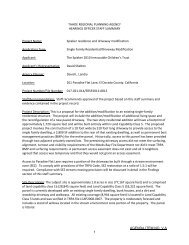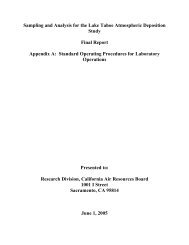FEIS - Tahoe Regional Planning Agency
FEIS - Tahoe Regional Planning Agency
FEIS - Tahoe Regional Planning Agency
You also want an ePaper? Increase the reach of your titles
YUMPU automatically turns print PDFs into web optimized ePapers that Google loves.
RESPONSE TO COMMENTS ON THE DEIS<br />
B o u l d e r B a y C o m m u n i t y E n h a n c e m e n t P r o g r a m P r o j e c t E I S<br />
starting the paragraph on p. 4-7-2. The Washoe Tribe is federally recognized and a<br />
sovereign government, with 1,600 members. Add Stewart to the list of communities<br />
and note that many members live away from tribal lands. Washoe are not "Indian<br />
Groups" but native people of Washoe ancestry.<br />
The following change will be made to page 4.7-2 of the DEIS.<br />
Ethnography<br />
The project area lies entirely within the territory of the Hokan-speaking Washoe<br />
people. While they were an informal and flexible political collectivity, Washoe<br />
ethnography hints at a level of technological specialization and social complexity for<br />
Washoe groups, non-characteristic of their surrounding neighbors in the Great Basin.<br />
Semisedentism and higher population densities, concepts of private property, and<br />
communal labor and ownership were reported and may have developed in<br />
conjunction with their residential and subsistence resource stability (d’Azevedo<br />
1986:473-476).<br />
Lake <strong>Tahoe</strong> was and remains both the spiritual and physical center of the Washoe<br />
world. The Washoe lived along its shores, and the locations of several Washoe<br />
encampments in the Lake <strong>Tahoe</strong> Basin have been reported. The project vicinity is<br />
near two important Washoe fishing campsites, ImgiwO'tha and MathOcahuwo'tha<br />
(d’Azevedo 1986:473-476).<br />
Currently, The Washoe Tribe is are a federally recognized tribe by the U.S.<br />
Government, is a sovereign government and has have maintained an established<br />
land base. Its approximately 1,200 1,600 tribal members are governed by a tribal<br />
council that consists of members of the Carson, Dresslerville, Woodfords, Stewart<br />
and Reno-Sparks communities, Indian groups, as well as a significant number of<br />
tribal members from non-reservation areas (Inter-Tribal Council of Nevada 1995<br />
and Darrel Cruz, Personal Communication, December 16, 2009).<br />
Comment 102-b: Comment Summary - On p. 4.7-11, note that inadvertent discoveries will be taken in<br />
consultation with the Washoe Tribe.<br />
Mitigation measure CUL-2: Identify and Protect Undiscovered Archaeological<br />
Resources requires consultation with the Washoe Tribe in the event that human<br />
remains or ethnographic resources are discovered during Project construction.<br />
Comment 102-c: Cultural Resources Study, page 7, last paragraph - Describe what is meant by<br />
"residual population", and clarify the Washoe are Hokan speakers, not surrounded<br />
by Numic speakers but between California and Great Basin tribes.<br />
The following change will be made to Cultural Resources Study, Page 7, paragraph<br />
3, line 7:<br />
Delete: “The Washoe are part of an ancient Hokan-speaking residual population,<br />
which has been subsequently surrounded by Numic-speaking intruders such as the<br />
Northern Paiute (Jacobsen 1966).”<br />
Insert: “The Washoe are descendants of an ancient Hokan-speaking population<br />
that was subsequently surrounded in prehistoric times by Numic-speaking<br />
incomers such as the Northern Paiute (Jacobsen 1966).”<br />
PAGE 8- 42 HAUGE BRUECK ASSOCIATES SEPTEMBER 8 , 2010






